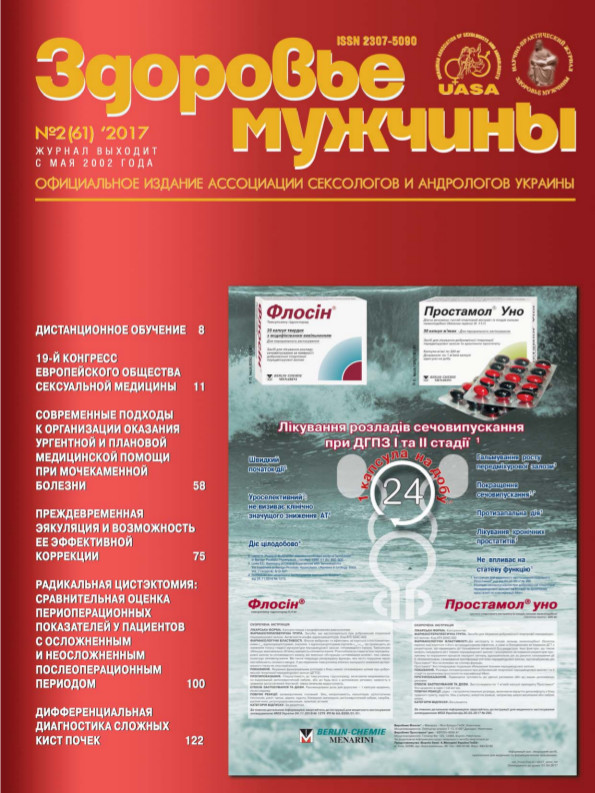The comparative analysis of results of retropubic and miniinvasive radical prostatectomy
##plugins.themes.bootstrap3.article.main##
Abstract
The objective: is to conduct a comparative analysis of complications of retropubic radical prostatectomy (RRP) and minimally invasive radical prostatectomy (MIRP) in patients with prostate cancer by determining the frequency and severity of postoperative complications.
Patients and methods. There were analyzed the medical history of 453 patients who underwent radical prostatectomy (RP) in conditions of SI «Institute of Urology of NAMS Ukraine» in 2013–2015 years and SI «V.K. Gusak’s Institute of Emergency and Recovery Surgery of NAMS Ukraine» during the 2006–2013 years. All patients were divided into two groups. Group I were consisted of 210 (46.4%) patients who underwent MIRP, and group II were included 243 (53.6%) patients after RRP. Complications were divided: by the number; by severity according to the scale P.A. Clavien et al. (2009); by type for G. Novara et al. (2010); by prognostic group formed by P.M. Pierorazio et al. (2013).
Results. The group, which were performed MIRP, were dominated genitourinary complications in case of 64,8±3,3% to 50,2±3,2% in the group, which were performed RRP (ч2=9,736, df=1; p2 =0,004, df=1; p>0,05); and the number of infectious complications was higher in the group, which were performed RRP, and amounted 8,6±1,8 % than in the group, which were performed MIRP, with amount 3,3±1,2% (Χ2 =5,474, df=1; p2 =1,152, df=1; p>0,05). Percentage absence of prostate cancer, according to the final postoperative histological study group, which were performed MIRP, composed 2,9±1,1%, while the group, which were performed RRP, 3,3±1,1%. Group I was illustrated statistically significantly more patients of II prognostic group: 30,5±3,2% to 22,2±2,7% (Χ2 =3,984, df=1; p2 =8,176, df=1; p<0,01), the difference in other prognostic groups was not statistically significant.
Conclusions. The number and nature of complications, which were recorded in study groups, demonstrates the need for further development of a set of measures aimed at preventing infectious complications and cardiocerebropulmonary group during RRP and genitourinary group during MIRP. The emergence of the vast number of complications of genitourinary group that were registered in the group, which were performed MIRP, depends on the stage of formation vesico-urethral anastamosis and can be substantially reduced by its improvement.
##plugins.themes.bootstrap3.article.details##

This work is licensed under a Creative Commons Attribution 4.0 International License.
Authors retain the copyright and grant the journal the first publication of original scientific articles under the Creative Commons Attribution 4.0 International License, which allows others to distribute work with acknowledgment of authorship and first publication in this journal.
References
Quinn M. Patterns and trends in prostate cancer incidence, survival, prevalence and mortality. Part II: individual countries / M. Quinn, P. Babb // BJU international. – 2002. – Vol. 90, No. 2. – P. 174–184.
Song C. Prostate cancer in Korean men exhibits poor differentiation and is adversely related to prognosis after radical prostatectomy / C. Song, J.Y. Ro, M.-S. Lee [et al.] // Urology. – 2006. – Vol. 68, No. 4. – P. 820–824.
Бюлетень національного канцерреєстру України No 17 // Рак в Україні, 2014–2015. – К., 2015. – С. 54–55.
Schuessler W.W. Laparoscopic radical prostatectomy: initial short-term experience / W.W. Schuessler, P.G. Schulam, R.V. Clayman, L.R. Kavoussi // Urology. – 1997. – Vol. 50, No. 6. – P. 854–857.
Raboy A. Early experience with extraperitoneal endoscopic radical retropubic prostatectomy / A. Raboy, P. Albert, G. Ferzli // Surgical endoscopy. – 1998. – Vol. 12, No. 10. – P. 1264–1267.
Pasticier G. Robotically assisted laparoscopic radical prostatectomy: feasibility study in men / G. Pasticier, J.B. Rietbergen, B. Guillonneau [et al.] // Eur. Urol. – 2001. – Vol. 40, No. 1. – P. 70–74.
Patel V. R. Pentafecta: a new concept for reporting outcomes of robot-assisted laparoscopic radical prostatectomy / V.R. Patel, A. Sivaraman, R.F. Coelho [et al.] // Eur. Urol. – 2011. – Vol. 59, No. 5. – P. 702–707.
Clavien P.A. The Clavien-Dindo classification of surgical complications: five-year experience / P.A. Clavien, J. Barkun, M.L. de Oliveira [et al.] // Annals of surgery. – 2009. – Vol. 250, No. 2. – P. 187–196.
Yoon P.D. Use of Clavien-Dindo classification in reporting and grading complications after urological surgical procedures: analysis of 2010 to 2012 / P.D. Yoon, V. Chalasani, H.H. Woo // J. Urol. – 2013. – Vol. 190, No. 4. – P. 1271–1274.
Pierorazio P.M. Prognostic gleason grade grouping: data based on the modified gleason scoring system: prognostic gleason grade grouping / P.M. Pierorazio, P.C. Walsh, A.W. Partin, J.I. Epstein // BJU International. – 2013. – Vol. 111, No. 5. – P. 753–760.
Novara G. Prospective evaluation with standardised criteria for postoperative complications after robotic-assisted laparoscopic radical prostatectomy / G. Novara, V. Ficarra, C.D’Elia [et al.] // Eur. Urol. – 2010. – Vol. 57, No. 3. – P. 363–370.
Gillitzer R. Single center comparison of anastomotic strictures after radical perineal and radical retropubic prostatectomy / R. Gillitzer, C. Thomas, C. Wiesner [et al.] // Urology. – 2010. – Vol. 76, No. 2. – P. 417–422.
Cormio L. Prognostic factors for anastomotic urinary leakage following retropubic radical prostatectomy and correlation with voiding outcomes / L. Cormio, G. Di Fino, C. Scavone [et al.] // Medicine. – 2016. – Vol. 95, No. 16.
Epstein J.I. A contemporary prostate cancer grading system: a validated alternative to the gleason score / J.I. Epstein, M.J. Zelefsky, D.D. Sjoberg [et al.] // Eur. Urol. – 2015. – P. 1–8.





